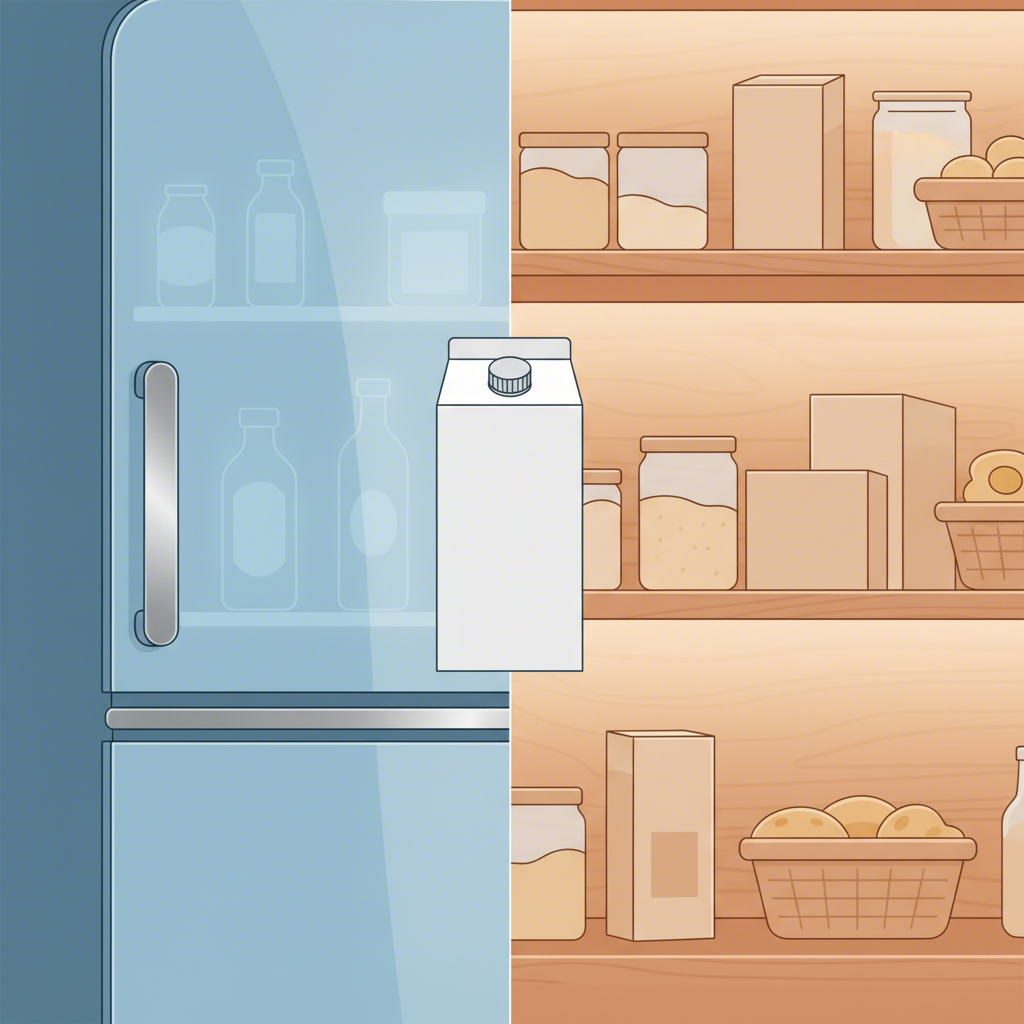TL;DR
Whether unopened soy milk needs refrigeration depends entirely on how it was packaged and sold. If you bought it from a pantry aisle in a shelf-stable carton, it does not need to be refrigerated before opening. However, if you purchased it from the refrigerated section of the store, it must be kept in the fridge, even when sealed. Once opened, all types of soy milk must be refrigerated.
The Two Types of Soy Milk: Shelf-Stable vs. Refrigerated
The confusion about storing soy milk stems from the two different ways it is processed and packaged. Understanding this distinction is the key to proper storage and ensuring your plant-based milk stays fresh and safe to drink. The simplest rule is to store it at home the same way it was stored at the grocery store.
First, there is shelf-stable soy milk. This product is treated with Ultra-High Temperature (UHT) processing, which sterilizes the milk by heating it to a very high temperature for a short time. It’s then poured into special aseptic (sterile) cartons that are designed to protect it from light, air, and contaminants. This combination of UHT treatment and aseptic packaging is what allows it to be stored unopened in your pantry for several months without spoiling. You’ll find these cartons in the non-refrigerated aisles of the supermarket, often near baking supplies or other plant-based milks.
The second type is refrigerated soy milk. This version is typically found in the dairy case alongside cow’s milk and other chilled beverages. While it is also pasteurized to kill harmful bacteria, the process is different from UHT, and the packaging is not designed for long-term pantry storage. This type of soy milk is perishable and must be kept consistently cold to prevent bacterial growth, even before you break the seal. Storing a chilled carton at room temperature can cause it to spoil quickly.

Storage Rules: Before and After Opening
Properly storing soy milk is straightforward once you know which type you have. Following these simple guidelines will preserve its quality and ensure it’s safe for consumption, preventing unnecessary waste and potential foodborne illness.
Before Opening the Carton
The storage location for unopened soy milk is determined by its packaging. There is no need to guess; the product’s placement in the store tells you everything you need to know.
- Shelf-Stable (Aseptic) Cartons: Store these in a cool, dark, and dry place like a pantry or cupboard. Refrigeration is not necessary until the seal is broken. They can typically be stored this way for months.
- Refrigerated Cartons: These must go directly into your refrigerator as soon as you get home. Do not leave them out on the counter. Even sealed, they are perishable and rely on cold temperatures to stay fresh.
After Opening the Carton
This rule is universal and critical: once opened, all soy milk must be refrigerated. As soon as the sterile seal is broken, the milk is exposed to airborne bacteria that can cause it to spoil. After opening, tightly reseal the carton and place it in the refrigerator immediately. Most manufacturers recommend consuming opened soy milk within 7 to 10 days for the best quality and safety. Always check the packaging for specific guidance.
For those who prefer the freshest possible product without worrying about store processing types, using a plant milk maker at home is a growing trend. Resources like Soy Milk Quick offer comprehensive guides on the best machines, allowing you to create additive-free soy, almond, or oat milk on demand.
How to Tell If Your Soy Milk Has Gone Bad
If you’re unsure about the freshness of your soy milk, trust your senses. There are several clear indicators that it has spoiled and should be discarded. Consuming spoiled milk can lead to digestive upset, so it’s always better to be cautious.
First, inspect the carton. If it appears bloated, puffy, or is leaking, this is a strong sign that bacteria have multiplied inside, producing gas and pressure. Do not consume the contents. When you pour the milk, check its texture. Fresh soy milk should be smooth and consistent. If it appears lumpy, curdled, or unusually thick, it has gone bad.
Your sense of smell is another reliable tool. Give the milk a quick sniff. A sour, off-putting, or generally “off” odor is a definitive sign of spoilage. If it looks and smells fine, you can perform a small taste test. A tiny sip will be enough to tell. If it tastes sour or unpleasant in any way, spit it out and discard the rest of the carton immediately.
Frequently Asked Questions About Storing Soy Milk
1. What soy milk doesn’t need to be refrigerated before opening?
Soy milk sold in shelf-stable, aseptic cartons does not need to be refrigerated before it’s opened. You can find this type of soy milk in the non-refrigerated aisles of grocery stores. It is specially processed and packaged to remain fresh at room temperature for several months.
2. How long does opened soy milk last in the fridge?
Once opened, soy milk should be tightly sealed and stored in the refrigerator. For the best quality and safety, it is recommended to consume it within 7 to 10 days. Always check the product’s label for the manufacturer’s specific recommendation.
3. Does this storage rule apply to other plant-based milks?
Yes, the same principle generally applies to other plant-based milks like almond, oat, and rice milk. If the product is sold in a shelf-stable carton from a pantry aisle, it can be stored at room temperature until opened. If it’s purchased from the refrigerated section, it must be kept cold at all times.
